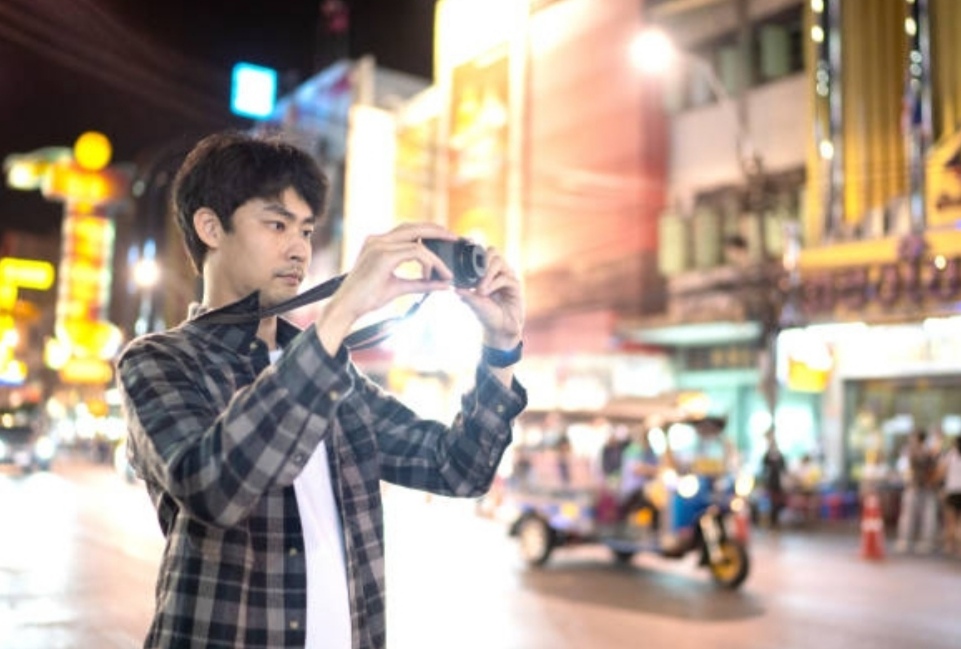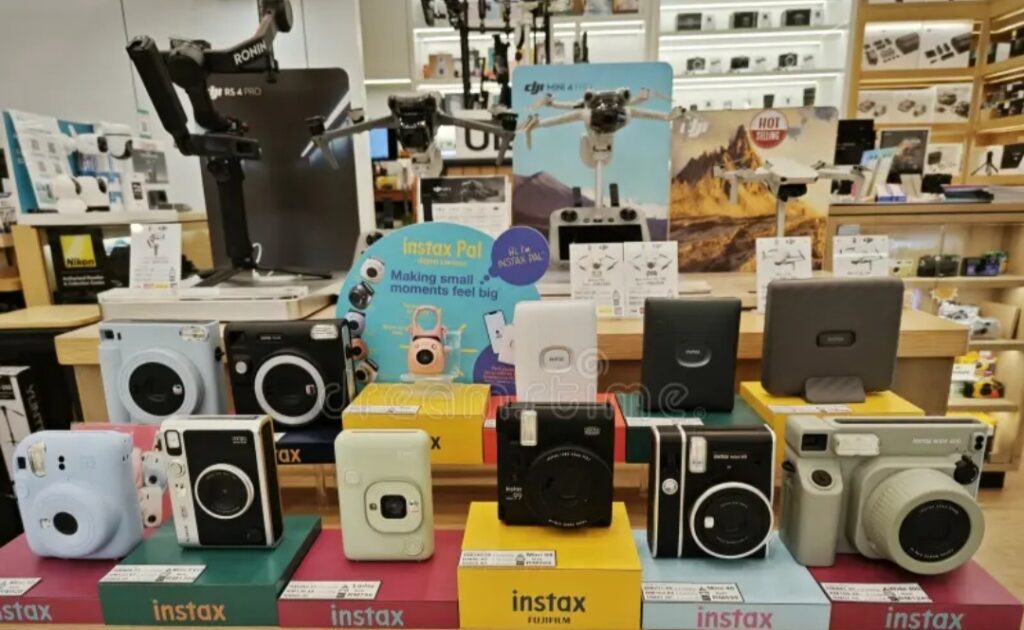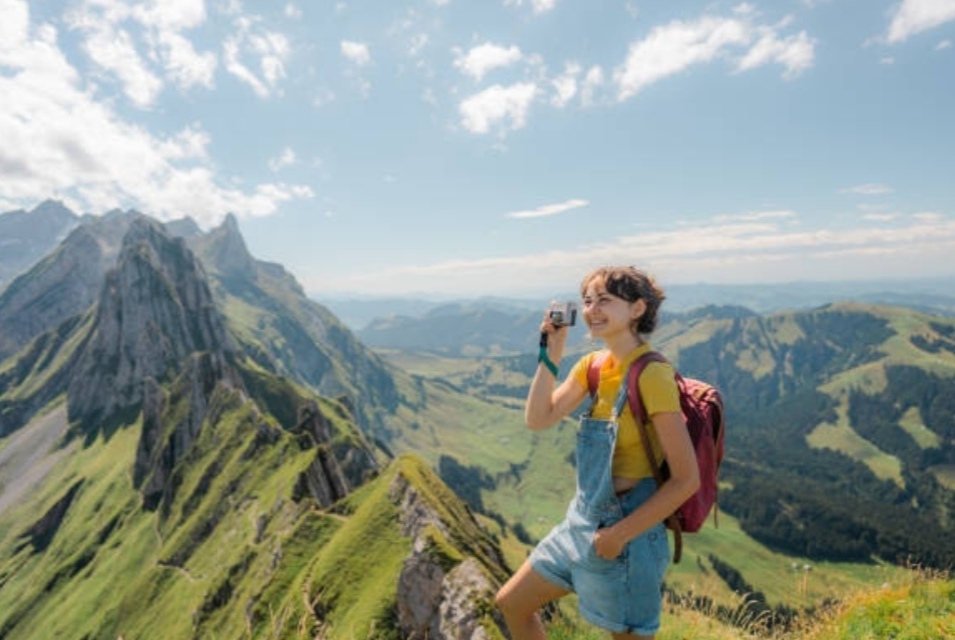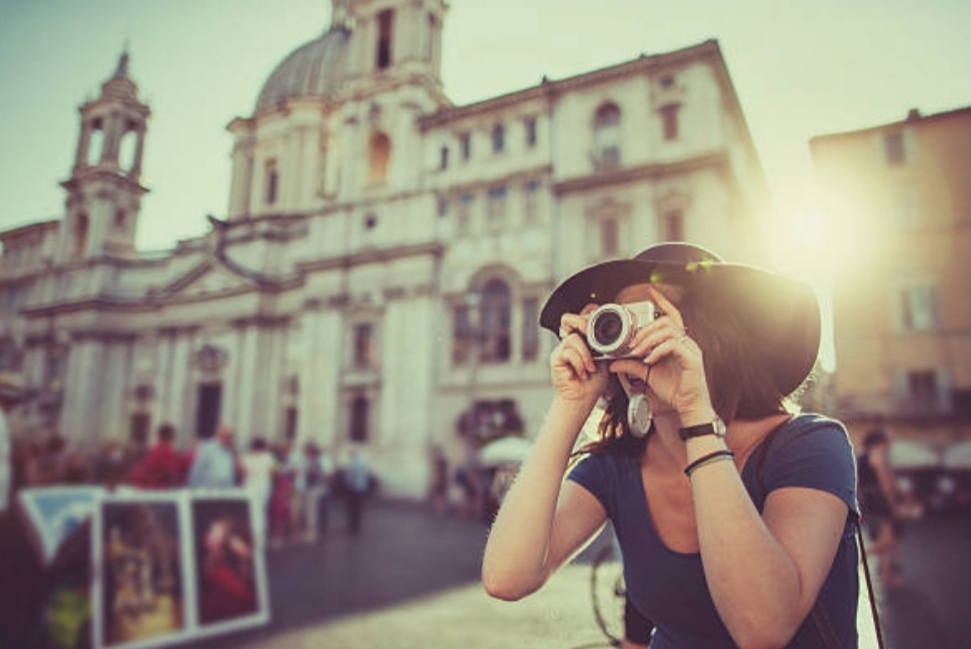Compact Digital Cameras for Photography
Compact digital cameras have become a go-to choice for photographers who value portability and convenience without compromising on performance.
With advancements in technology, these cameras have evolved to deliver image quality that rivals larger DSLR and mirrorless systems.
In this section, we’ll explore the growing demand for compact cameras and how modern innovations make them an ideal solution for photographers on the go.

The Growing Demand for Compact Digital Cameras
The popularity of compact digital cameras has surged in recent years.
As people increasingly prioritize mobility and efficiency, compact digital cameras have emerged as a top choice for travelers, vloggers, and casual photographers alike.
Unlike bulky DSLR systems, compact cameras fit easily into pockets or small bags, making them perfect for spontaneous shooting.
Many photographers appreciate the lightweight design of compact cameras, especially during long trips where carrying heavy gear can be a burden.
These cameras are particularly appealing to travelers who want to capture professional-quality images without the need for multiple lenses and heavy equipment.
Moreover, the rise of social media platforms like Instagram and TikTok has fueled the demand for easy-to-carry cameras that deliver stunning visuals.
Compact cameras strike a perfect balance between convenience and quality, allowing photographers to produce shareable, eye-catching content effortlessly.
Technological Advancements in Compact Digital Cameras
In the past, compact cameras were often viewed as secondary to larger DSLR or mirrorless options.
However, modern innovations have redefined their capabilities, allowing them to compete on equal footing with their larger counterparts.

Improved Sensor Technology
Compact cameras now feature advanced sensors that rival those found in professional systems.
Many models are equipped with 1-inch sensors or even APS-C sensors, which significantly enhance image quality.
These sensors capture more light, resulting in sharper details, vibrant colors, and improved low-light performance.
For instance, the Sony RX100 series is renowned for its impressive 1-inch sensor, delivering images that are crisp and dynamic.
Similarly, the Fujifilm X100V boasts an APS-C sensor, making it a favorite among street photographers who demand exceptional image clarity.
Advanced Autofocus Systems
Another technological leap in compact cameras is the integration of advanced autofocus systems.
Modern compact cameras use phase-detection or hybrid autofocus to achieve rapid and precise focusing.
This feature is particularly useful for capturing moving subjects, such as in wildlife or sports photography.
Enhanced Video Capabilities
Compact digital cameras have also embraced the growing demand for high-quality video.
Many models now offer 4K video recording, slow-motion capabilities, and external microphone support, making them a preferred choice for vloggers and content creators.
Cameras like the Canon PowerShot G7 X Mark III are specifically designed with video creators in mind.
Versatile Lens Options
While compact cameras typically come with fixed or integrated lenses, these lenses are increasingly versatile.
Models like the Panasonic Lumix LX100 II combine wide-angle and telephoto capabilities in a single lens, offering flexibility for a variety of shooting scenarios.
The inclusion of high-quality optics ensures sharp images, even at maximum zoom levels.
Connectivity and Smart Features
Today’s compact cameras are equipped with Wi-Fi, Bluetooth, and even app integration, enabling instant sharing of photos and videos.
These features align perfectly with the needs of a tech-savvy audience that values convenience and seamless connectivity.
Durability and Weather Resistance
For outdoor photographers, durability is a key factor.
Many compact cameras now offer weather-sealed bodies, protecting them from dust, moisture, and light impacts.
This makes them suitable for shooting in challenging environments, such as beaches, forests, or urban streets during unpredictable weather.
Why Compact Digital Cameras Are Perfect for On-the-Go Photography
The combination of portability, advanced features, and high image quality makes compact cameras an ideal choice for photographers who are always on the move.
Whether you’re exploring a bustling city, hiking through scenic trails, or documenting your everyday life, a compact camera is a reliable companion that delivers professional results without the bulk.
- Quick Tip: When selecting a compact digital camera, prioritize features like sensor size, zoom range, and battery life to ensure it meets your specific needs.

If you’re looking to elevate your photography game, invest in one of the best compact digital cameras available today.
Explore our top recommendations and find the perfect fit for your style. Click here to see the best deals and reviews!
Key Features to Consider in Compact Digital Cameras
One of the most critical aspects to consider when choosing a compact digital camera is the sensor size and quality.
This feature plays a pivotal role in determining the overall image quality, low-light performance, and the ability to capture fine details.
Below, we’ll dive deep into why sensor size matters and compare the most common sensor sizes found in the best compact digital cameras available today.
Sensor Size and Its Impact on Image Quality
The sensor is the heart of any digital camera.
It is responsible for capturing light and converting it into digital data that forms the final image.
The larger the sensor, the more light it can capture, resulting in better image quality, especially in challenging lighting conditions.
Compact digital cameras are designed to balance portability with performance, and their sensors are carefully engineered to offer the best of both worlds. Here’s why sensor size is a crucial factor:
- Improved Image Quality: Larger sensors can capture more light, resulting in sharper details, better dynamic range, and more vibrant colors. This is why cameras with 1-inch or APS-C sensors often outperform those with smaller sensors.
- Low-Light Performance: A larger sensor can gather more light in dim conditions, reducing noise and maintaining image clarity. This is a key advantage when shooting at night or indoors without flash.
- Depth of Field Control: Larger sensors provide better depth of field control, allowing photographers to achieve professional-looking background blur (bokeh) for portraits and close-ups.
For photographers who prioritize image quality, investing in a compact camera with a larger sensor is always a smart decision.

Comparing Common Sensor Sizes in Compact Cameras
Compact cameras come with a variety of sensor sizes, each catering to different user needs. Here’s a breakdown of the most common sensor sizes and how they compare:
1. 1-Inch Sensors
- Widely used in premium compact cameras like the Sony RX100 series.
- Balances excellent image quality with portability.
- Performs well in both bright and low-light conditions.
- Ideal for travelers, vloggers, and everyday photography enthusiasts.
2. APS-C Sensors
- Found in high-end compact models like the Fujifilm X100V.
- Larger than 1-inch sensors, offering superior image quality.
- Delivers stunning details, exceptional dynamic range, and excellent low-light performance.
- Perfect for photographers who want DSLR-like quality in a smaller package.
3. Micro Four Thirds Sensors
- Featured in cameras like the Panasonic Lumix LX100 II.
- Offers a good balance between sensor size and compactness.
- Known for versatility, suitable for both still photography and video recording.
4. Smaller Sensors (1/2.3-Inch and 1/1.7-Inch)
- Common in entry-level compact cameras.
- While smaller sensors are less capable in low light, they are still suitable for casual users and budget-conscious buyers.
- Great for beginners or those upgrading from smartphone cameras.
Which Sensor Size Should You Choose?
Choosing the right sensor size depends on your needs and photography style:
- If you prioritize portability and still want excellent quality, a 1-inch sensor camera is ideal.
- For professionals or enthusiasts seeking DSLR-like performance, an APS-C sensor is worth considering.
- Budget-conscious buyers or beginners may find smaller sensors sufficient for casual use.
The Role of Sensor Resolution
While sensor size is critical, resolution (measured in megapixels) also plays an important role.
Compact cameras today typically feature resolutions between 12MP and 20MP, which is more than enough for high-quality prints and digital sharing.
However, it’s important to note that higher resolution does not always mean better image quality, especially if the sensor size is small.
Why Sensor Size Matters for the Best Compact Digital Cameras
The best compact digital cameras combine sensor size, resolution, and advanced technology to deliver outstanding results.
Cameras like the Sony RX100 VII, Fujifilm X100V, and Panasonic Lumix LX100 II are perfect examples of how manufacturers optimize sensor technology for both casual and professional users.
- Quick Tip: Always check the sensor size before buying a compact camera. It’s a key indicator of image quality and performance. Click here to explore cameras with top-tier sensors!
Best Compact Digital Cameras for Photography on the Go
When it comes to finding the best compact digital cameras, 2025 has brought a fantastic lineup of models that combine portability, cutting-edge technology, and exceptional performance.
Whether you’re a traveler, content creator, or street photography enthusiast, there’s a perfect option for you.
Below are the top picks that cater to a variety of photography needs and styles.

Top Picks of the Best Compact Digital Cameras for Photography
Let’s explore the best compact digital cameras that stand out this year.
Sony RX100 VII – The All-Rounder
The Sony RX100 VII continues to reign as one of the most versatile compact cameras on the market.
This model is known for packing high-end features into a sleek and portable body, making it ideal for photographers who need a reliable all-rounder.
- Key Features:
- 1-inch Exmor RS CMOS sensor: Offers exceptional image quality with vibrant colors and sharp details.
- 24-200mm zoom lens: This versatile lens covers everything from wide-angle landscapes to telephoto shots.
- 4K video capabilities: Delivers ultra-high-definition footage with advanced stabilization for smooth recordings.
- Real-Time Eye AF and Tracking: Perfect for capturing moving subjects with precision.
- Pros:
- Compact and lightweight design.
- Superb autofocus system for stills and video.
- High-resolution pop-up electronic viewfinder (EVF).
- Cons:
- Premium price tag.
- Limited manual controls compared to DSLRs.
Best For:
The Sony RX100 VII is a dream come true for travelers, vloggers, and anyone who values portability without compromising on performance.
Its ability to shoot high-quality photos and videos makes it a top contender among the best compact digital cameras in 2025.
Fujifilm X100V – The Style Icon
The Fujifilm X100V blends timeless aesthetics with modern technology, making it a favorite among street photographers and style-conscious users.
- Key Features:
- APS-C X-Trans CMOS 4 sensor: Ensures exceptional image clarity and low-light performance.
- Fixed 23mm f/2 lens: Ideal for street photography and environmental portraits.
- Retro design: Aesthetic appeal with intuitive dials for manual controls.
- Hybrid optical and electronic viewfinder: Offers flexibility for composing shots.
- Pros:
- Excellent build quality with weather-sealing.
- Superior color science for vibrant and film-like images.
- Easy to use for beginners and professionals alike.
- Cons:
- Fixed lens may limit versatility for some users.
- No in-body image stabilization (IBIS).
Best For:
If you’re a street photography enthusiast or someone who values aesthetics and image quality, the Fujifilm X100V is a must-have.
Its retro charm and cutting-edge performance make it one of the best compact digital cameras this year.
Canon PowerShot G7 X Mark III – The Vlogger’s Dream
The Canon PowerShot G7 X Mark III has become a go-to choice for content creators, thanks to its vlogging-friendly features.
- Key Features:
- Flip-up touchscreen: Allows easy framing for selfies and vlogs.
- 4K video recording: Shoots stunning videos with no crop.
- External microphone support: Ensures crystal-clear audio for content creation.
- Fast f/1.8-2.8 lens: Delivers excellent low-light performance.
- Pros:
- Compact and travel-friendly design.
- Built-in live-streaming capabilities for social media.
- Smooth autofocus for both stills and videos.
- Cons:
- Limited zoom range compared to competitors.
- Average battery life.
Best For:
The Canon PowerShot G7 X Mark III is perfect for vloggers, content creators, and anyone looking for a compact camera with robust video capabilities.
Panasonic Lumix LX100 II – The Hybrid Shooter
The Panasonic Lumix LX100 II is a hybrid camera designed for photographers who want excellent stills and video performance in one compact package.
- Key Features:
- Micro Four Thirds sensor: Offers larger-than-average performance in a compact form.
- Versatile 24-75mm equivalent lens: Covers most shooting scenarios.
- Advanced manual controls: Ideal for creative photographers.
- 4K Photo Mode: Extract stills from high-resolution video.
- Pros:
- Excellent image quality for a compact camera.
- Great handling with dedicated dials and controls.
- Lightweight yet robust build.
- Cons:
- Fixed lens limits versatility.
- Smaller sensor compared to APS-C rivals.
Best For:
The Panasonic Lumix LX100 II is an excellent choice for hybrid shooters who need a camera that excels in both still photography and video.
Ricoh GR III – The Minimalist’s Choice
The Ricoh GR III is a pocket-sized powerhouse that focuses on delivering exceptional image quality in a minimalist design.
- Key Features:
- APS-C sensor: Produces stunningly detailed images with superb dynamic range.
- Fixed 28mm equivalent lens: Perfect for street and documentary photography.
- Compact and lightweight: Slips easily into any pocket.
- Shake Reduction (SR): Helps maintain image clarity even at slower shutter speeds.
- Pros:
- Ultra-portable design.
- Intuitive controls for quick adjustments.
- Impressive macro mode for close-ups.
- Cons:
- No viewfinder included.
- Limited to a fixed lens.
Best For:
The Ricoh GR III is a top choice for minimalist photographers, street shooters, and anyone who values portability without sacrificing image quality.
Each camera listed here represents the best compact digital cameras for specific needs and shooting styles in 2025.
Whether you prioritize versatility, style, or simplicity, there’s a perfect compact camera waiting for you. Discover exclusive deals on these top cameras today!
How to Choose the Right Compact Camera for Your Needs
Selecting the best compact digital cameras can be overwhelming with so many options available.
To make an informed decision, it’s crucial to evaluate your photography style, budget, and preferences.
This section breaks down the essential factors to help you find the perfect camera.

Determining Your Photography Style
Understanding your photography needs is the first step in finding the right compact camera.
Different cameras excel in specific situations, so knowing your preferences can save time and money.
- Portrait Photography:
If you love capturing portraits, look for cameras with larger sensors like APS-C or Micro Four Thirds for shallow depth of field and beautiful background blur (bokeh).
Features like portrait-friendly lenses and face/eye autofocus are also essential. For example, the Sony RX100 VII offers excellent portrait performance in a compact form.
- Landscape Photography:
For landscape enthusiasts, a wide-angle lens is key.
Compact cameras with high dynamic range (HDR) and manual control allow you to capture expansive scenery in stunning detail.
Models like the Panasonic Lumix LX100 II, with its versatile zoom lens, are perfect for this.
- Street Photography:
Street photographers often need a discreet, fast, and lightweight camera.
Cameras like the Ricoh GR III and Fujifilm X100V are ideal due to their compact design, fast shutter response, and intuitive controls.
- Vlogging and Content Creation:
If video content is your focus, look for cameras with 4K video recording, a flip-up screen, and microphone support for enhanced audio quality.
The Canon PowerShot G7 X Mark III is a standout choice for vloggers.
Pro Tip: Think about how often you shoot and in what environments. A travel photographer may need weather-sealing, while vloggers may prioritize portability and video quality.
Budget Considerations
Your budget will significantly influence the type of compact camera you can afford. The good news is there are excellent options for every price range.
- Affordable Options for Beginners:
Entry-level compact cameras like the Canon PowerShot SX740 HS offer great features at a lower price point.
These models are ideal for hobbyists and beginners looking for a step up from smartphone photography.
- Look for features like image stabilization, manual mode, and decent zoom ranges without breaking the bank.
- Many affordable cameras now include basic 4K video recording and Wi-Fi connectivity for seamless sharing.
- Premium Compact Cameras for Professionals:
Professional photographers or serious enthusiasts may want to invest in higher-end models like the Sony RX100 VII or Fujifilm X100V.
These cameras provide larger sensors, premium lenses, and advanced features like real-time autofocus tracking and RAW shooting.
- Expect features like weather-sealing, manual controls, and superior low-light performance.
- Though pricier, these cameras deliver exceptional image quality and durability, making them worth the investment.
Pro Tip: If you’re unsure about spending a lot upfront, consider refurbished models or previous-generation cameras that still offer excellent performance at a reduced price.
Comparing Compact Cameras to Smartphones
With advancements in smartphone photography, many wonder whether compact cameras are still necessary.
While smartphones are convenient, compact cameras still hold distinct advantages in certain scenarios.
- Advantages of Compact Cameras Over Smartphones:
- Superior Image Quality: Compact cameras often have larger sensors, resulting in better low-light performance and dynamic range.
- Optical Zoom: Unlike digital zoom on smartphones, compact cameras offer optical zoom, preserving image quality even at high magnifications.
- Manual Controls: Dedicated controls for aperture, shutter speed, and ISO allow for greater creative freedom compared to smartphones.
- Battery Life: Compact cameras generally last longer during extended shooting sessions, especially for video recording.
- Situations Where Compact Cameras Excel:
- Travel Photography: Compact cameras like the Sony RX100 VII are lightweight yet powerful, making them perfect for capturing everything from cityscapes to wildlife.
- Professional-Looking Portraits: Features like adjustable lenses and bokeh effects provide a level of sophistication that smartphones can’t match.
- Video Creation: Many compact cameras shoot 4K video with advanced stabilization and offer external mic support, making them ideal for vloggers and filmmakers.
While smartphones are improving, compact cameras remain indispensable tools for enthusiasts and professionals seeking higher-quality results.
Pro Tip: A compact camera complements your smartphone rather than replacing it. Use your smartphone for quick snapshots and your camera for serious photography.
By considering your photography style, budget, and understanding the advantages of compact cameras, you can confidently choose the best compact digital camera that meets your needs. Explore the latest models and find your perfect match today!
Compact Digital Cameras vs. Mirrorless and DSLR Cameras
When deciding on a camera, it’s essential to weigh the pros and cons of compact digital cameras, mirrorless cameras, and DSLRs.
While each type has its advantages, compact digital cameras offer a unique blend of portability, ease of use, and advanced features, making them an excellent choice for many photographers.
This section explores the key differences and highlights scenarios where compact digital cameras excel.

Performance Comparison
Performance is a critical factor when comparing camera types, especially if you’re trying to decide between compact digital cameras, mirrorless cameras, and DSLRs.
Here’s a closer look at the differences.
- Image Quality Differences:
DSLRs and mirrorless cameras generally have larger sensors, such as APS-C or full-frame, which offer superior image quality, especially in low-light conditions.
However, modern best compact digital cameras like the Sony RX100 VII and Canon PowerShot G7 X Mark III now include advanced sensors that produce exceptional image quality despite their smaller size.
Compact digital cameras often have fixed lenses that are fine-tuned for their sensors, ensuring sharp and consistent performance.
While they might not achieve the same level of detail as high-end mirrorless or DSLR systems, they are more than capable for casual photographers, vloggers, and travelers.
- Portability Advantages of Compact Cameras:
One of the biggest advantages of compact digital cameras is their size and weight.
They are lightweight and easily fit into your pocket or small bag, unlike DSLRs or mirrorless cameras, which often require a separate camera bag for lenses and accessories.
For instance, the Ricoh GR III, with its minimalist design, is perfect for street photography without drawing attention.
This portability makes compact cameras ideal for spontaneous shooting, where carrying a bulky DSLR might be inconvenient.
Additionally, many compact cameras now include powerful zoom capabilities, such as the 24-200mm range on the Sony RX100 VII, allowing photographers to shoot a variety of subjects without changing lenses.
- Ease of Use:
Compact cameras are designed with simplicity in mind, featuring intuitive controls and automatic shooting modes.
This makes them accessible for beginners while still offering manual controls for enthusiasts.
In contrast, DSLRs and mirrorless cameras can feel overwhelming for newcomers due to their extensive settings and interchangeable lens systems.
Compact digital cameras strike a balance, allowing users to shoot high-quality photos without the complexity.
Ideal Scenarios for Compact Cameras
While DSLRs and mirrorless cameras have their advantages, compact cameras shine in specific situations. Let’s explore the ideal use cases for these versatile devices.
- Travel Photography:
When traveling, convenience is key. Compact digital cameras offer an unbeatable combination of portability and performance.
Models like the Panasonic Lumix LX100 II deliver excellent image quality while remaining lightweight and compact, perfect for capturing everything from bustling city streets to serene landscapes.
With features like built-in stabilization and weather-resistant designs, compact cameras are reliable companions for travelers who want to focus on their journey rather than managing heavy equipment.
- Everyday Use:
Compact cameras are perfect for everyday photography, from family gatherings to quick snapshots during a walk.
Unlike bulky DSLRs, they are easy to carry and ready to shoot in seconds.
Cameras like the Canon PowerShot G7 X Mark III offer versatile performance for both photos and videos, making them an excellent choice for documenting daily life.
- Casual Shooting:
For casual photographers who don’t want to invest heavily in a DSLR or mirrorless system, compact cameras provide a cost-effective alternative.
They combine affordability with excellent features, such as Wi-Fi connectivity, creative filters, and smartphone integration for instant sharing.
- Vlogging and Content Creation:
Compact digital cameras like the Sony ZV-1 are tailor-made for vloggers and content creators.
With flip-out screens, 4K video recording, and external microphone support, these cameras cater to the needs of creators who want professional-quality content without the complexity of larger systems.
Pro Tip: If you’re primarily shooting in well-lit conditions or need a camera for everyday use, a compact digital camera is often more practical than a DSLR or mirrorless option.
When choosing between compact digital cameras, DSLRs, and mirrorless cameras, it ultimately comes down to your specific needs and preferences.
If you prioritize portability, ease of use, and affordability, the best compact digital cameras offer a compelling solution.
Their advanced features and lightweight design make them perfect for travel, casual photography, and even professional-quality vlogging.
Explore the top-rated compact cameras today and find your perfect match for every photography scenario!
Essential Accessories for Compact Digital Cameras
Investing in the best compact digital cameras is just the first step to elevating your photography.
To truly maximize your camera’s potential, you’ll need the right accessories.
These tools not only enhance the functionality of your camera but also make your shooting experience more seamless and enjoyable.
Let’s dive into the must-have accessories and how they can transform your photography journey.

Must-Have Accessories
Every photographer, whether a beginner or a professional, needs a set of essential accessories to get started.
These items ensure your compact camera is always ready to perform at its best.
- Camera Cases for Protection:
A sturdy camera case is a must to protect your compact digital camera from dust, scratches, and accidental drops.
Look for options with padded interiors, water-resistant materials, and adjustable compartments.
Brands like Lowepro and Peak Design offer stylish yet functional cases designed specifically for compact cameras.
For those who prefer a minimalist approach, silicone sleeves or hard-shell cases are lightweight and provide just the right amount of protection without adding bulk.
- Spare Batteries for Uninterrupted Shooting:
Compact cameras, while efficient, often have limited battery life, especially when shooting in high resolution or recording 4K videos.
Carrying spare batteries ensures you never miss a shot.
Choose original batteries from your camera manufacturer or reputable third-party options like Wasabi Power for affordability and reliability.
Pro Tip: Always charge your spare batteries before a shoot and store them in a protective case to avoid damage.
- High-Speed SD Cards:
To store your high-resolution photos and videos, invest in high-speed SD cards with ample capacity.
Look for cards with a minimum Class 10 or UHS-I rating to ensure smooth recording and quick data transfer.
Popular brands like SanDisk and Lexar offer reliable options with capacities ranging from 32GB to 1TB.
Using a high-quality SD card also minimizes the risk of data corruption, which can be devastating after a long day of shooting.
- Portable Tripods for Stability:
A portable tripod is essential for capturing sharp images, long-exposure shots, and steady videos.
Compact tripods like the Joby GorillaPod or Manfrotto PIXI Mini are lightweight, easy to carry, and perfect for travel photography.
For added flexibility, choose a tripod with adjustable legs and a 360-degree ball head for creative angles. This accessory is particularly useful for vloggers and landscape photographers.
- External Flashes for Better Lighting:
While compact cameras have built-in flashes, they often lack the power and flexibility of external flashes.
An external flash like the Godox TT350 provides more control over lighting, reducing harsh shadows and overexposure.
Some compact cameras support hot-shoe-mounted flashes, allowing you to explore advanced lighting techniques like bounce and off-camera flash photography.
Enhancing Your Photography Experience
Accessories that go beyond the basics can elevate your skills and creativity.
These tools add versatility to your compact camera, making it suitable for various shooting styles and environments.
- Editing Software Recommendations:
Post-processing is an integral part of photography, and having the right software can make a world of difference.
Industry standards like Adobe Lightroom and Photoshop offer comprehensive editing tools for color correction, retouching, and adding creative effects.
For beginners, free alternatives like GIMP or Darktable provide excellent functionality without the price tag. Many compact cameras also come with proprietary software, such as Sony’s Imaging Edge or Canon’s Digital Photo Professional, for basic edits.
Editing software allows you to fine-tune your photos, ensuring they look professional and share-worthy.
- Lens Attachments for Added Versatility:
While compact cameras typically come with fixed lenses, you can expand their capabilities using lens attachments.
Wide-angle, macro, and telephoto adapters attach directly to your camera lens, allowing you to experiment with different perspectives.
For instance, a wide-angle lens attachment is perfect for landscapes and architecture, while a macro attachment lets you capture stunning close-ups of small subjects like flowers or insects. Popular brands like Moment and Ulanzi offer high-quality lens attachments compatible with most compact cameras.
- Cleaning Kits for Maintenance:
Keeping your camera clean is essential for maintaining image quality and extending its lifespan.
Invest in a cleaning kit that includes a lens pen, microfiber cloth, air blower, and cleaning solution. These tools help remove dust, smudges, and fingerprints from your camera lens and body.
Regular maintenance ensures your compact camera performs optimally, especially in challenging environments like sandy beaches or humid jungles.
- Screen Protectors for Durability:
A screen protector shields your camera’s LCD from scratches and smudges, preserving its clarity.
Tempered glass protectors are durable and easy to apply, ensuring your camera remains in pristine condition.
Many modern compact cameras, such as the Sony RX100 VII, feature touchscreens, making screen protection even more crucial.
Pro Tip: Accessories like lens attachments and tripods not only enhance your photography but also help you explore creative techniques, making your shots stand out from the crowd.
Equipping your compact digital camera with the right accessories is essential for unlocking its full potential.
From spare batteries and high-speed SD cards to editing software and lens attachments, each accessory plays a crucial role in enhancing your photography experience.
Discover top-rated camera accessories to pair with the best compact digital cameras today!
With these tools in hand, you’ll be ready to capture stunning images, whether you’re traveling, vlogging, or exploring everyday moments. Invest in the right gear now and elevate your photography to the next level!
Frequently Asked Questions
When exploring the best compact digital cameras, buyers often have numerous questions regarding their features, performance, and suitability for specific needs.
Below, we address some of the most common inquiries to help you make an informed decision.

What Makes a Camera a Compact Digital Camera?
A compact digital camera, often referred to as a point-and-shoot, is designed for simplicity and portability.
Unlike DSLR or mirrorless cameras, compact cameras usually have a fixed lens, making them ideal for beginners and casual photographers.
Compact digital cameras are known for their ease of use, offering automatic settings that adjust to various lighting conditions and scenarios.
These cameras are lightweight, pocket-sized, and perfect for everyday use, travel, or quick snapshots.
Despite their small size, many modern compact cameras, like the Sony RX100 VII or Canon PowerShot G7 X Mark III, deliver excellent image quality comparable to larger camera systems.
Are Compact Digital Cameras Better Than Smartphones?
While smartphones have improved in camera quality, compact digital cameras still have distinct advantages.
Compact cameras often feature larger sensors, which produce sharper images with better low-light performance.
Another advantage is the optical zoom, which compact cameras like the Panasonic Lumix ZS200 offer without sacrificing image quality.
Smartphones typically rely on digital zoom, leading to a loss of clarity.
Additionally, compact cameras come with advanced manual controls, external flash compatibility, and sometimes even viewfinders, giving photographers more creative flexibility.
For those who prioritize portability with better image quality than a smartphone, compact cameras are a great choice.
What Should I Look for When Buying a Compact Digital Camera?
Choosing the right compact camera depends on your needs. Here are the key factors to consider:
- Image Quality: Look for cameras with larger sensors, such as 1-inch or APS-C, for superior performance in various lighting conditions. Models like the Canon PowerShot G5 X Mark II excel in this area.
- Zoom Range: Consider the optical zoom capability for distant subjects. Cameras like the Sony HX99 offer impressive zoom ranges without compromising image quality.
- Portability: Choose lightweight and pocket-friendly models if you travel frequently or need a camera for casual use.
- Video Features: For vloggers or content creators, 4K recording, image stabilization, and a flip-out screen are essential features.
- Connectivity: Built-in Wi-Fi or Bluetooth allows you to transfer images directly to your devices for quick sharing.
- Battery Life: A camera with long-lasting battery life, or the option for spare batteries, ensures you’re always ready to shoot.
By focusing on these aspects, you can narrow down your choices and find the best compact digital camera that meets your specific requirements.
Are Compact Cameras Suitable for Professional Photography?
Compact cameras can be suitable for certain professional scenarios, especially when portability is a priority.
For example, travel bloggers, event photographers, and content creators often use high-end compact cameras like the Sony ZV-1 or Fujifilm X100V to capture high-quality images and videos on the go.
While they lack interchangeable lenses, many compact cameras offer advanced features such as RAW shooting, manual controls, and exceptional image processing, making them versatile tools for professionals.

Can I Change the Lens on a Compact Camera?
Most compact cameras come with fixed lenses, meaning the lens cannot be changed. However, you can enhance their versatility using lens attachments.
Wide-angle, macro, and telephoto adapters are available for many models, enabling you to expand your creative possibilities without switching cameras.
For those who prioritize interchangeable lenses, mirrorless cameras may be a better choice, though they are less portable than compact options.
How Do I Maintain My Compact Digital Camera?
Proper maintenance extends the life of your compact camera and ensures consistent performance. Here’s a quick guide:
- Regular Cleaning: Use a microfiber cloth to clean the lens and LCD screen. Avoid using harsh chemicals.
- Protective Cases: Store your camera in a padded case to prevent damage from dust, moisture, or accidental drops.
- Battery Care: Charge your battery fully before use and avoid leaving it in extreme temperatures.
- Firmware Updates: Regularly check for software updates from the manufacturer to ensure your camera has the latest features and fixes.
- Lens Maintenance: If your camera supports lens attachments, clean the lens threads and adapters to maintain clarity.
By following these steps, you can keep your compact camera functioning like new for years to come.
How Do Compact Digital Cameras Perform in Low Light?
Compact cameras with larger sensors, such as 1-inch or APS-C, perform exceptionally well in low-light conditions. Models like the Sony RX100 VII or Canon PowerShot G7 X Mark III are equipped with advanced image stabilization and wide-aperture lenses, allowing them to capture detailed images even in challenging lighting.
For those who frequently shoot in low light, look for cameras with high ISO capabilities and built-in flash support to enhance your results.
Are Compact Digital Cameras Worth It in 2025?
Absolutely. Despite the rise of smartphone photography, compact digital cameras continue to hold their place for enthusiasts and professionals who value portability and advanced features.
With technological advancements, modern compact cameras offer impressive specifications like 4K video recording, high-speed burst shooting, and AI-based scene recognition.
If you’re looking for a balance between convenience and quality, investing in the best compact digital cameras is a decision you won’t regret.
Compact digital cameras remain a versatile and reliable choice for photography enthusiasts.
Whether you’re a beginner exploring the basics or a seasoned professional seeking portability, these cameras cater to a wide range of needs.
Still have questions? Explore our top picks for compact cameras to find the perfect match for your photography goals!
Conclusion of the Best Compact Digital Cameras
Choosing the best compact digital cameras is a rewarding decision that caters to a wide variety of photography needs.
Whether you’re a casual hobbyist, a travel enthusiast, or a budding content creator, compact cameras offer a perfect balance of portability, performance, and user-friendly features.
These small yet powerful devices prove that size doesn’t limit creativity, especially with the advancements in technology over the past decade.

Why Compact Digital Cameras Are Still Relevant
In an era dominated by smartphone photography, compact cameras remain an essential tool for capturing high-quality images and videos.
Unlike smartphones, compact cameras are equipped with larger sensors, superior lenses, and advanced features that deliver results comparable to professional-grade equipment.
For example, models like the Sony RX100 VII or the Canon PowerShot G7 X Mark III provide a level of precision and clarity that smartphones simply cannot match.
Compact cameras also excel in low-light scenarios, thanks to their wide apertures and optical zoom capabilities.
This makes them an invaluable companion for travel, events, or any situation where you want to ensure top-notch photo quality.
The Versatility of Modern Compact Cameras
Modern compact digital cameras are more versatile than ever.
They cater to a broad audience, from beginners who appreciate the simplicity of automatic settings to professionals who demand manual controls and advanced features like 4K video recording or RAW image capture.
High-end models such as the Fujifilm X100V and Panasonic Lumix LX100 II offer hybrid capabilities, bridging the gap between compact convenience and professional functionality.
These cameras are ideal for vlogging, street photography, or capturing breathtaking landscapes.
With options for external flashes, lens attachments, and advanced connectivity features, compact cameras empower users to push their creative boundaries without the bulk and complexity of larger camera systems.
Making the Right Investment
When considering an investment in a compact digital camera, it’s essential to assess your photography needs and prioritize features that align with them.
For instance, if portability is your main concern, lightweight and slim models like the Canon PowerShot ELPH 360 HS are perfect.
If you’re a vlogger or content creator, cameras such as the Sony ZV-1 offer features like flip-out screens, external microphone ports, and excellent video stabilization.
Travelers or wildlife enthusiasts may benefit from cameras with extended optical zoom capabilities, like the Panasonic Lumix ZS200.
Remember, compact cameras are not just tools—they’re long-term investments in your ability to capture and share life’s most meaningful moments.
Final Tips for Choosing the Best Compact Digital Camera
When shopping for the best compact digital cameras, keep these tips in mind:
- Compare Models: Use comparison tools or detailed reviews to evaluate features, image quality, and value for money.
- Consider Accessories: A camera is only as good as the accessories you pair with it. Camera cases, spare batteries, and high-speed SD cards can significantly enhance your experience.
- Think About Your Goals: Are you buying a camera for casual photography, travel, or professional content creation? Let your purpose guide your choice.
- Check Reviews and Recommendations: Read reviews from trusted sources to ensure you’re investing in a reliable product.
- Try Before You Buy: If possible, visit a store to test different models and get a feel for their ergonomics and performance.
The Bottom Line
Compact digital cameras continue to offer unparalleled value for photographers of all skill levels.
Their combination of high-quality optics, advanced features, and portability makes them a worthy addition to any photography enthusiast’s toolkit.
If you’re still undecided, take the time to explore some of the top models on the market.
Browse our curated selection of the best compact digital cameras, and find the perfect device to elevate your photography experience.
Don’t wait to capture your memories in stunning detail! Discover the best compact digital cameras today and start your journey toward better photography.
Make the investment in a tool that combines convenience, performance, and creativity in one compact package.
Take your photography to the next level—choose a compact camera that fits your lifestyle and unlock your creative potential!
You might also like :

